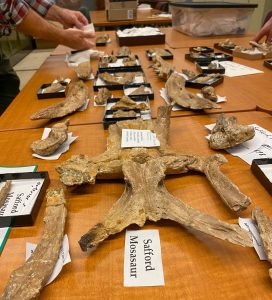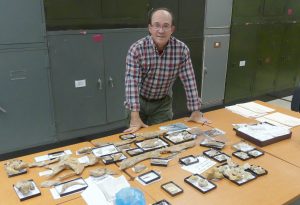This month, a 75-million-year-old mosasaur fossil from Alabama was graciously donated to the paleontology collections of the Alabama Museum of Natural History. A 2-feet-long skull is remarkably complete warrants further study by specialists.
Mosasaurs are ancient marine reptiles that were the top predators during the late part of the Cretaceous period (~100 to 66 million years ago). These giants could grow up to about 60 feet (18 m) and were common hunters in the shallow ocean covering most of Alabama during this time.

The newly donated specimen, identified as Plioplatecarpus sp. (ALMNH:Paleo:698), was found near Safford in Dallas County in 1996 by students of Northwest Florida State College, Niceville, Florida. Dr. Jon Bryan (professor at Northwest Florida State College) directed the collecting, preparing, and initial study of the specimen. Earlier in the year, he and UA Museums’ Curator of Paleontology Dr. Adiel Klompmaker revisited the site near Safford with permission, but no additional bones were discovered.

“The skull was discovered during a field trip led by former NWFSC faculty member (and University of Alabama geology graduate student), Ms. Mona Williams (now deceased),” Dr. Bryan said. “Williams took her Historical Geology class to the area, and with permission of the landowner, surveyed the area for fossils. Some students found a handful of bone fragments and teeth, brought them to Mona and asked. “Ms. Williams, is this anything?”. Mona told them to go stand right where they found that! More was there. Some scraps were brought back to the college. That’s when I got involved. We had some instruction in field collecting of vertebrate fossils, then launched an “expedition” to recover the skull,” Dr. Bryan explained.
The skull is ~75% complete, but most of the rest of the skeleton was not found. Only some ribs, vertebra, and limb elements were preserved in addition to the skull. The mosasaur lived in an environment together with at least fish, worm tubes, oysters, and giant clams, all of which were found very close to the skull.

Dr. Bryan transported the mosasaur to Tuscaloosa on November 11th for the official donation. When asked why he donated the skull to the museum, Jon Bryan said, “The specimen was found in Alabama and belongs in the Alabama Museum of Natural History, which has one of the largest mosasaur collections in the world.” Long-term volunteer, research associate, and mosasaur enthusiast Dr. Bing Blewitt agrees, and he has determined that the museum collection contains more than 1000 mosasaur specimens.
The mosasaur specimen is now stored in the paleontology collections in Mary Harmon Bryant Hall on the University of Alabama campus. This collection consisting of at least 500,000 fossil specimens. “This specimen is an important addition to our continuously expanding fossil collection,” Dr. Klompmaker said. “In fact, the research on this specimen is already ongoing, so stay tuned for more news about this specimen in years to come!”